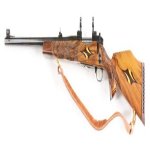I'm lookin for common traits of early bolt action European stalking and sporting rifles. lets from from the 1890's to 1930's
English and German or anywhere in Europe
this is opinion based and I'm just looking for things you have noticed about them in general
traits I picked up on or noticed but could be wrong/mistaken (please correct if I am);
ebony or horn fore stock tip attached at 90* usually pretty short 30ish mm long
lots of drop, around 50-55mm and very little over the length of the butt stock maybe 6mm (mainly bespoke lee speed rifles, mausers seem to have less drop)
pistol grip stock with grip cap made of horn or none at all just rounded wood grip
the fore stock is more like a pear shape then round or parallel or flat sides
cheek pieces or not but none of the monte carlo style
slender oval shapes pistol grip more so then round or squarish
shorter fore stock length, usually a few inches shorter the the barrel mid point
thin combs
I'm sure there is more,
are they known for shorter, longer or average lop?
do they have much cast built into them?
what is the normal pitch for a hard butt plate in the early 1900's?
English and German or anywhere in Europe
this is opinion based and I'm just looking for things you have noticed about them in general
traits I picked up on or noticed but could be wrong/mistaken (please correct if I am);
ebony or horn fore stock tip attached at 90* usually pretty short 30ish mm long
lots of drop, around 50-55mm and very little over the length of the butt stock maybe 6mm (mainly bespoke lee speed rifles, mausers seem to have less drop)
pistol grip stock with grip cap made of horn or none at all just rounded wood grip
the fore stock is more like a pear shape then round or parallel or flat sides
cheek pieces or not but none of the monte carlo style
slender oval shapes pistol grip more so then round or squarish
shorter fore stock length, usually a few inches shorter the the barrel mid point
thin combs
I'm sure there is more,
are they known for shorter, longer or average lop?
do they have much cast built into them?
what is the normal pitch for a hard butt plate in the early 1900's?
Last edited:
















































































